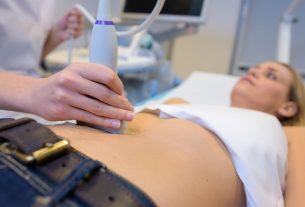To confirm the diagnosis of appendicitis, in addition to evaluating symptoms, such as pain on the right side of the abdomen, the doctor must perform a physical evaluation by palpating the abdomen to check for the presence of inflammation in the appendix and peritoneum, which is a membrane that covers the abdominal organs.
Generally, through analysis of symptoms and physical assessment, the doctor can confirm the diagnosis of appendicitis. However, imaging tests, such as an X-ray or CT scan, or laboratory tests, such as a blood count or urine analysis, may still be ordered to rule out other conditions that also cause pain on the right side of the abdomen.
Appendicitis is inflammation of the appendix, which is a part of the large intestine, located on the lower right side of the abdomen, and is generally caused by the accumulation of feces and bacteria, and should be treated as quickly as possible as soon as symptoms appear, to prevent avoid complications such as infection or abdominal abscess. Find out how appendicitis is treated.
The diagnosis of appendicitis is usually made by a surgeon or general practitioner, following some steps:
1. Assessment of symptoms
The initial diagnosis of appendicitis is made by evaluating symptoms, such as pain located in the lower right part of the abdomen and/or pain around the navel, which begins suddenly, mildly and may worsen within a few hours.
Furthermore, pain on the right side of the abdomen may be accompanied by other symptoms such as nausea, loss of appetite, fever or general malaise, for example. See other symptoms of appendicitis.
Online test to find out if it could be appendicitis
If you think you may have appendicitis, list your symptoms:
2. Physical examination
After the initial assessment of symptoms, the doctor must perform a physical examination by palpating the abdomen to detect changes suggestive of inflammation, using some techniques that include:
- Blumberg sign: This exam consists of applying light pressure to the lower right part of the abdomen, called McBurney’s point, and when this pressure is suddenly relieved, the pain worsens, which indicates inflammation of the appendix and peritoneum;
- Sinal de Rovsing: In this type of exam, the doctor applies light pressure to the lower left side of the abdomen, which is considered positive for appendicitis, when the person feels pain on the right side, even though the left side of the abdomen has been palpated;
- Psoas sign: This exam is performed with the person lying on their left side, and the doctor performs a hip extension on the right side, and is considered positive for acute appendicitis when the person feels pain on the right side of the abdomen;
- Dumphy Sign: In this exam, the doctor asks the person to cough, and if they feel pain in the lower right side of the abdomen, it may indicate appendicitis.
In addition, the doctor may do a digital rectal examination to examine the rectum, which is the final part of the intestine. Another test that can be done is a pelvic examination in women of childbearing age to assess whether the pain may be caused by gynecological problems.
If you want to make an appointment with a doctor, use our tool to find a specialist near you:
Taking care of your health has never been easier!
3. Imaging exams
Some imaging tests, such as abdominal X-rays, computed tomography and ultrasound, may be indicated to confirm the diagnosis of appendicitis and rule out other causes of pain on the right side of the abdomen.
4. Laboratory tests
The doctor may also order laboratory tests, such as a complete blood count, to detect infections, and a urine test to assess whether the pain on the right side of the abdomen is being caused by a urinary infection or kidney stones, for example.
The symptoms of appendicitis can vary from person to person, and pain on the right side of the abdomen can have several other causes and, therefore, it can be difficult to confirm the diagnosis in some cases. In any case, it is important that people go to the emergency room if they have symptoms of appendicitis. Learn about other causes of abdominal pain and when it can be serious.
Bibliography
- MATOS, Breno. et al.. Acute appendicitis. Rev Med Minas Gerais 2011; 21(2 Suppl 4): S1-S113.
- MINISTRY OF HEALTH. Appendicitis. Available at: <http://bvsms.saude.gov.br/dicas-em-saude/2900-apendicite>. Accessed on February 18, 2020

Sign up for our newsletter and stay up to date with exclusive news
that can transform your routine!
Warning: Undefined array key "title" in /home/storelat/public_html/wp-content/plugins/link-whisper-premium/templates/frontend/related-posts.php on line 12
Warning: Undefined array key "title_tag" in /home/storelat/public_html/wp-content/plugins/link-whisper-premium/templates/frontend/related-posts.php on line 13




